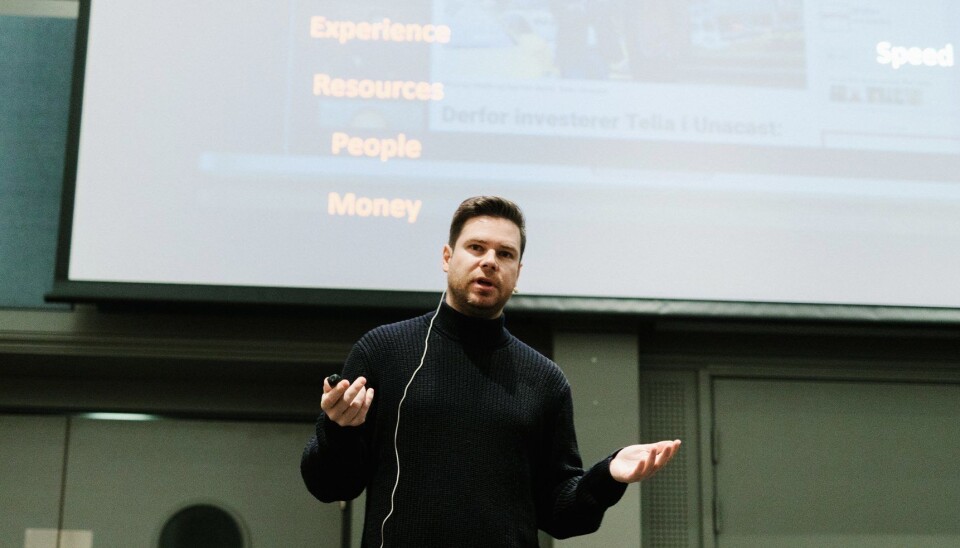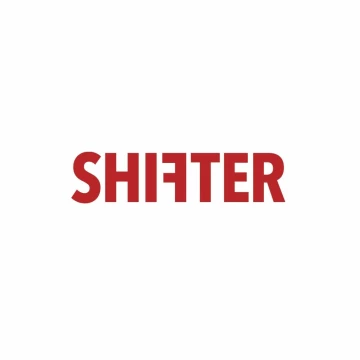-

Finance Manager (vikariat) | StartupLab
-

Data Engineer | Klaveness Digital
-

Medeiere* | Boitano AS
-

Chief Operating Officer (COO) | ROEST
-

CEO | Kontur AS
-

VP Marketing | Glint Solar
-

Ingeniører innen kontroll, elektronikk og datasyn | Munin
-

Senior Developer | Klaveness Digital
-

Integration Engineer | MIMIRO
-

AI Engineer | Noteless

How to succeed in partnerships with corporates: Pac-Man - you can stop running away now.
Opinion by Kjartan Slette, COO and co-founder of Unacast
Last year Telia joined Unacast as an investor. After several cautionary tales in Norway over the last years of corporates not getting it right when cooperating with startups, it was so good to experience an example of the opposite.
How to succeed in partnerships with corporates (and Pac-Man). This was the title of my keynote presentation at the technology and innovation conference The Shift late last year.
I used visual imagery from the arcade game Pac-Man to illustrate the difference between a corporate and a startup. I wanted to comment on how these two can best work together and to argue that they most often do not work well together at all even if they are in the same game.My point was straight forward. To best work together one must first understand the differences in strengths. Obviously, the corporate has many strengths, while the startup in most cases only have one. The worst-case outcome of not understanding this is that the corporate devours the startup. That’s why Pac-Man is running away.

While it’s easy to spot the difference in size between the corporate and the startup most don’t understand the differences in strengths, and thus the corporate can end up unwittingly taking away the only real advantage the startup has: Speed (as in bringing new disruptive ideas to market quick)
This is a logical chain of events as the bigger party naturally and typically would want the start up to tap into their way of working with processes and methodology. If the corporate and the startup truly understood their individual strengths it should be the opposite. The corporate should instead let the startup drive processes and methodologies, and support with their strengths: Experience, resources, people, money, and many more.

Yes, the point of my keynote was straight forward, and hopefully easy to theoretically grasp, but I am well aware that this is much harder to actually implement. Theory and practice are not always friendly with each other.
To take a page out of our own book, or rather presentation, in late 2018 we got to test our own theories and actually implement these in a partnership with Telia - a global telecom company with over 20.000 employees. Unacast has 40.
Background
In our 2018 Series B capital raise, Telia joined the round as an investor - for two reasons. Similar to their previous investment in Spotify they were motivated by both the financial upside and also the opportunity to find operational synergies.
This is not known to many (yet), but Telia has built a robust new revenue arm around data and crowd insights and it is growing fast. By understanding aggregated and anonymous data from phones that ping cell-towers Telia is able to offer unprecedented insights around crowd movements in society over time. This is fundamentally a game-changer and potentially a catalyst for everything from building better cities, improving citizens way of life, to optimizing transportation.
The problem and the project
As Telia’s opportunities around crowd insights grew so did their business need to deliver these insights to more customers and more demanding customers, with higher precision, higher quality, higher transparency, and faster. And as it happens, this is exactly what Unacast does every single day as a leading location data company in the US. But, for Telia to get value from Unacast we needed to externalize our tech platform and adapt it to cell-tower data.
So, post the investment, we set up a joint project, and this is where Telia proved to us and the startup ecosystem that they get it. They get how to form agile and result-orientated projects where both parties can play on their strengths. They get how a modern corporate can successfully work with a smaller, but innovative, startup.
In practice, they allowed us, the startup, to lead the project: Project Cosmogony. And this is how we did it - in ten steps:
1. Unacast project managed the project as the project owner – with Telia as the product owner
2. We used Unacast technology stack in the cloud - to build products fast
3. We used Unacast communication tools and project management tools, like Slack and Coda – to communicate fast
4. Telia contributed with access to data, knowledge, capital and people to make sure the project had the muscles needed to achieve ambitious goals – to grow fast
5. The entire team was located at the Unacast offices (Yes, Telia employees ate lunch with Unacast every day and even joined the Unacast Christmas party)
6. Each week the project checked in with all the key stakeholders from both companies, also the ones not working 100% on this project
7. Each month the project communicated with the management teams on both sides to make sure everyone was informed of our progress
8. If there were blockers on either the Telia or Unacast side they were swiftly fixed, and the speed of the project and Unacast as a whole was never compromised
9. Not once did Telia interfere to force the scope or direction. Not once did they second guess our decisions. Not once did they not believe in Unacast and all the people that worked hard every day to bring this project past the goal post
10. The project hit every single milestone and OKRs
The results are in – and the theories are initially proven
Now, six months later, I’m happy and proud to say that we have produced ground-breaking work together that is ready to go into production. We have disrupted how to combine cutting-edge location technology with massive amounts of cell-tower data to launch higher precision, higher quality, higher transparency, and faster insights products than previously available.
On a more knowledge-based level we have as a startup learned a lot from working with a big corporate like Telia, especially from their industry domain expertise within cell-tower based products. I would go so far as to say it has fundamentally changed our company’s DNA.
And, while I can’t speak for Telia, I would argue they too have learned something from us. And one example is their newfound love of putting their technology up into the cloud, even experimenting with the same cloud provider as us – Google Cloud Platform.
To summarize: We have created new products and new insights that can be commercialized, and both parties have come out stronger and wiser on the other side of the project. High scores all around.
A new generation of power couples
After several cautionary tales in Norway over the last years of corporates not getting it right when cooperating with startups, it was so good to experience an example of the opposite. Even better, as the project leader I was able to experience it up close and personal and also to benefit directly from the immense amounts of energy that is released when a corporate and a startup understand how to maximize each other strengths.
Together Telia and Unacast were able to redefine a product category – and was heavily featured in news articles and on stage.
Other corporates should learn from this – because right now Telia has an advantage over others when it comes to these types of collaborations. And I’m sure they’ll going to take advantage of it.
And Pac-Man - you can stop running away now.



